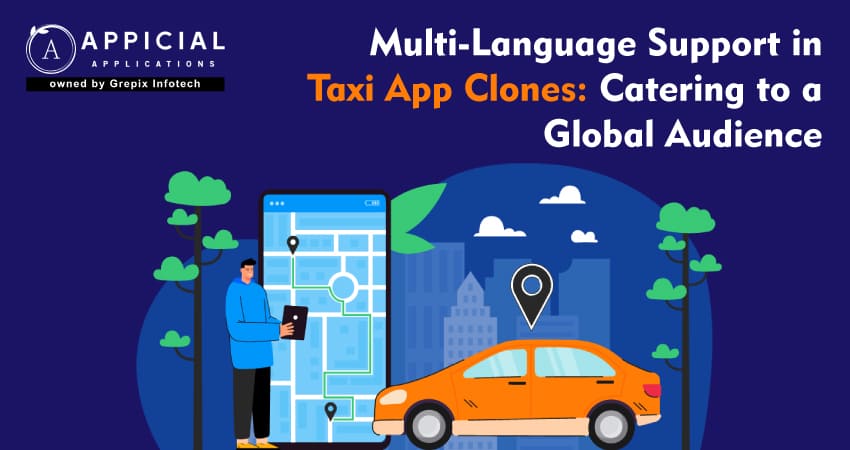
Multi-Language Support in Taxi App Clones: Catering to a Global Audience
Imagine you’re standing on a bustling street corner in downtown Tokyo. It’s late. You're in a hurry. You pull out your phone, open a taxi app, and... it’s all in English. Not a single line in Japanese. You fumble through the menus, trying to guess which button means "book now" and praying you didn’t just accidentally tip your driver 1000 yen.
Now picture this you’re in rural Argentina, phone in hand, trying to pay for your ride. But the app? It’s in French. Not Spanish. Not even broken Spanglish. Just French. Confusing doesn’t even begin to describe it.
Frustrating, right?
Now flip the script.
What if your taxi app clone welcomed you in your native language the moment you opened it? Not just translated text, but thoughtful localization that feels familiar. Suddenly, everything becomes easier. Booking a ride feels intuitive. Navigating the app feels comfortable. You trust it. You’re more likely to use it again.
That’s the magic of language.
In the fast-moving, hyper competitive world of ride-hailing, where users have dozens of choices and zero patience, that connection matters more than ever. Whether you're building for Lagos, Lisbon, or Lahore, taxi app clone language support isn’t just a “nice-to-have.” It’s non-negotiable. It’s mission-critical.
It’s what turns your app from usable to lovable.
So in this blog, we're going to break it all down. Why language diversity in apps is essential. How to build for it. How it shapes the user experience. And how companies are winning or losing based on how well they localize.
You’ll find insights, practical takeaways, and real world case studies that show what works (and what doesn’t). Whether you're launching in one new region or scaling to ten different countries, this is the roadmap you didn’t know you needed. Buckle up your ride to global readiness starts here.
Language isn’t just a bunch of words strung together—it’s how people connect, understand, and feel seen. In the digital world, especially in ride-hailing, language becomes the bridge between tech and trust. When building a multilingual taxi app, overlooking language support doesn’t just mean a clunky experience. It can mean shutting out entire communities who don’t feel welcomed, understood, or even able to use your platform.This blog explores why taxi app clone language support is essential if you aim to build a truly global ride-hailing app. We’re not talking about tossing in Google Translate and calling it a day. We're diving into the real strategies—how to implement multi-language features thoughtfully, how to enhance the user experience for riders and drivers alike, and how the big names in the business are already setting the standard.
Importance of Language Diversity
It's Not Just Globalization, It’s Personalization
You might think globalization is all about expanding reach, and sure, that’s part of it. But true expansion comes from personalization—making your service feel local even when it isn’t. This is where multilingual taxi app development shines.
Studies have shown that users are far more likely to engage with an app that communicates in their native language. And it’s not just about basic understanding. It’s about trust. People trust apps that “speak their language” because it shows respect and effort.
Bridging the Trust Gap
In places where literacy levels or familiarity with English are low, monolingual apps alienate users. We’re talking entire demographics potential revenue streams cut off because of language.
So, if you're building a global ride-hailing app, you’ve got to treat taxi app clone language support as a foundational element, not an afterthought. It’s not just UI it’s UX, brand credibility, and growth strategy rolled into one.
Implementation Strategies
Alright, enough preaching. Let’s talk shop. How do you actually go about adding multiple languages to a multilingual taxi app?
1 Build with Localization in Mind
Don’t wait till the last minute to “translate stuff.” Design your app architecture to support language packs or dynamic content rendering from the get-go.
Use Unicode. Avoid hardcoding text. Keep your strings external. Trust me, future-you will thank you.
2 Hire Human Translators (Not Just AI)
Yeah, I know AI translators are faster and cheaper. But nuance matters. A word that works in Spain might fall flat in Mexico. Local dialects, slang, context... these can make or break user experience.
Get actual human translators familiar with the regions you're targeting. Or at least have a human review automated translations.
3 Context-Aware Translations
Don’t just translate the literal meaning translate the intent. Your “Ride Now” button might be better phrased as “Voy Ahora” in Spanish-speaking regions, depending on local usage.
Also, test these translations in-app. Context is king. A perfect sentence in a vacuum might look ridiculous on a small screen or wrapped around a button.
4 Dynamic Switching
Allow users to switch languages seamlessly ideally from the onboarding screen. Auto-detecting device language is great, but don’t make it a trap. Let users choose.
5 Support RTL and Complex Scripts
Languages like Arabic, Hebrew, or Urdu use right to left (RTL) scripts. Supporting these isn’t as simple as flipping text alignment. It requires redesigning layout logic to ensure intuitive flow.
Same goes for languages like Hindi, Chinese, or Thai. Font rendering, spacing, and readability are different beasts. Tame them early.
Enhancing User Experience: Tips You Should Adopt
So you’ve added multiple languages. Great. But don’t stop there. Let’s look at how to enhance the experience, not just “check the box.”
Emotional UX
When your driver app says “Thank you!” in Hindi (“धन्यवाद!”) or the rider screen welcomes a user in Swahili (“Karibu!”), it builds emotional resonance. These micro-interactions create familiarity and warmth.
Think beyond translation. Think tone, warmth, and cultural alignment.
Voice Support and Chatbots
If your app includes voice support (for bookings or support), ensure these systems are multilingual too. The same goes for in-app chat. Nothing’s worse than getting help in a language you don’t speak when you're already stressed.
Notifications and Push Messages
Yes, even push notifications should be localized. You don’t want users receiving ride updates or promo alerts in English when they’ve selected Turkish.
Also mind the time zones and local holidays. A promo for Diwali means nothing in Brazil, and a Christmas deal might need tweaking for users in the Middle East.
Regional Payment Descriptions
Some languages require specific terms for financial services to avoid legal confusion. In Japan, for example, your app may need to show very specific kanji for tax-inclusive fare explanations.
It’s these little things that go a long way.
Also Read: On-Demand Drone Delivery App Development: Transforming The Future Of Logistics
Case Studies
Let’s zoom out and see who’s getting it right.
Uber
It’s no surprise Uber leads the charge. They support dozens of languages including Arabic, Hindi, Indonesian, and even regional dialects in Africa. What makes them successful isn’t just volume it’s execution. Each language version feels like it was made for that region.
Their onboarding flow also dynamically suggests language based on GPS and device settings a smooth touch.
Grab
Southeast Asia’s ride hailing hero, Grab, nails localization. In places like Vietnam, Thailand, and Indonesia, they don't just translate—they localize offers, payment gateways, even driver training modules.
This isn't just smart it’s necessary. Users in these regions aren’t just dealing with language diversity, but also mobile literacy challenges.
Bolt (Formerly Taxify)
Operating in over 45 countries, Bolt’s secret sauce is tight localization. They tailor their taxi app clone language support with a local-first approach, including partnerships with local payment wallets and region-specific driver onboarding content.
This hybrid approach of localization + language support = pure win.
Appicial Applications: Your Global Taxi App Clone Partner
If you’re thinking, “Okay, all this makes sense, but how do I build something like this?”—I’ve got good news.
Appicial Applications has been doing this for years. They specialize in taxi app clones that come pre equipped with robust taxi app clone language support. We’re talking scalable, real-time switchable, RTL friendly, and even culturally adaptable platforms that are truly multilingual taxi app-ready.
They don’t just hand over code they build launch ready, region-sensitive, global ride-hailing app solutions that can hit the ground running in any market you want to enter. From Latin America to the Middle East, from Southeast Asia to Eastern Europe they’ve got you covered.
Plus, they’ll walk you through everything from translation tools to UI alignment to app store localization. It’s a no-brainer for startups and enterprises alike.
Conclusion
We live in a world where a rider in Mumbai and a driver in Nairobi can both rely on the same platform if that platform respects their language, culture, and context.
Multilingual taxi app development isn’t just a tech trend. It’s a business strategy. It’s user respect. It’s market adaptability.
So whether you're building your first global ride hailing app or scaling an existing one, don’t skimp on taxi app clone language support. Invest in it. Nurture it. Make it a core feature, not a toggle switch.
And if you're looking for a trusted partner to do this right, check out Appicial Applications. They’ve made global scalability feel downright local.
Because at the end of the day, your app shouldn’t just move people from point A to B it should speak to them every step of the way.
Looking out to start your own venture like Uber ? Try out our HireMe Taxi Uber Clone, the easiest way to kick-start your taxi business.Author's Bio

Vinay Jain is the Founder at Grepix Infotech and brings over 12 years of entrepreneurial experience. His focus revolves around software & business development and customer satisfaction.
Back to blog list




